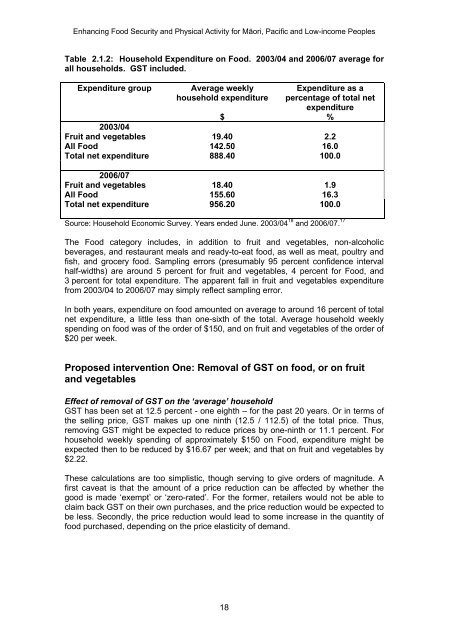enhancing food security and physical activity for maori, pacific and ...
enhancing food security and physical activity for maori, pacific and ...
enhancing food security and physical activity for maori, pacific and ...
- No tags were found...
You also want an ePaper? Increase the reach of your titles
YUMPU automatically turns print PDFs into web optimized ePapers that Google loves.
Enhancing Food Security <strong>and</strong> Physical Activity <strong>for</strong> Māori, Pacific <strong>and</strong> Low-income PeoplesTable 2.1.2: Household Expenditure on Food. 2003/04 <strong>and</strong> 2006/07 average <strong>for</strong>all households. GST included.Expenditure groupAverage weeklyhousehold expenditureExpenditure as apercentage of total netexpenditure%$2003/04Fruit <strong>and</strong> vegetables 19.40 2.2All Food 142.50 16.0Total net expenditure 888.40 100.02006/07Fruit <strong>and</strong> vegetables 18.40 1.9All Food 155.60 16.3Total net expenditure 956.20 100.0Source: Household Economic Survey. Years ended June. 2003/04 18 <strong>and</strong> 2006/07. 17The Food category includes, in addition to fruit <strong>and</strong> vegetables, non-alcoholicbeverages, <strong>and</strong> restaurant meals <strong>and</strong> ready-to-eat <strong>food</strong>, as well as meat, poultry <strong>and</strong>fish, <strong>and</strong> grocery <strong>food</strong>. Sampling errors (presumably 95 percent confidence intervalhalf-widths) are around 5 percent <strong>for</strong> fruit <strong>and</strong> vegetables, 4 percent <strong>for</strong> Food, <strong>and</strong>3 percent <strong>for</strong> total expenditure. The apparent fall in fruit <strong>and</strong> vegetables expenditurefrom 2003/04 to 2006/07 may simply reflect sampling error.In both years, expenditure on <strong>food</strong> amounted on average to around 16 percent of totalnet expenditure, a little less than one-sixth of the total. Average household weeklyspending on <strong>food</strong> was of the order of $150, <strong>and</strong> on fruit <strong>and</strong> vegetables of the order of$20 per week.Proposed intervention One: Removal of GST on <strong>food</strong>, or on fruit<strong>and</strong> vegetablesEffect of removal of GST on the ‘average’ householdGST has been set at 12.5 percent - one eighth – <strong>for</strong> the past 20 years. Or in terms ofthe selling price, GST makes up one ninth (12.5 / 112.5) of the total price. Thus,removing GST might be expected to reduce prices by one-ninth or 11.1 percent. Forhousehold weekly spending of approximately $150 on Food, expenditure might beexpected then to be reduced by $16.67 per week; <strong>and</strong> that on fruit <strong>and</strong> vegetables by$2.22.These calculations are too simplistic, though serving to give orders of magnitude. Afirst caveat is that the amount of a price reduction can be affected by whether thegood is made ‘exempt’ or ‘zero-rated’. For the <strong>for</strong>mer, retailers would not be able toclaim back GST on their own purchases, <strong>and</strong> the price reduction would be expected tobe less. Secondly, the price reduction would lead to some increase in the quantity of<strong>food</strong> purchased, depending on the price elasticity of dem<strong>and</strong>.18
















